Add this eBook to your basket to receive access to all 3,194 records. Our indexes include entries for the spelling foster. In the period you have requested, we have the following 3,194 records (displaying 2,221 to 2,230): These sample scans are from the original record. You will get scans of the full pages or articles where the surname you searched for has been found. Your web browser may prevent the sample windows from opening; in this case please change your browser settings to allow pop-up windows from this site. Members of the Association for Promoting the Extension of The Contagious Diseases Act, in London
(1869)
The Contagious Diseases Act of 1866 had as its first objective the establishment of isolation hospitals for the treatment of soldiers and sailors afflicted with smallpox, typhoid, measles, chicken pox, malaria, scarlet fever, bubonic plague, dysentery, enteric fever and other infectious conditions. This association was formed to lobby for the extension of the Act to the civil population of the United Kingdom. The membership was drawn not just from the medical profession and those interested in the administration of the poor law, but also from concerned individuals throughout society. The membership list was published alphabetically by area: the scan shows the start of the names for Leicester. | Sample scan, click to enlarge
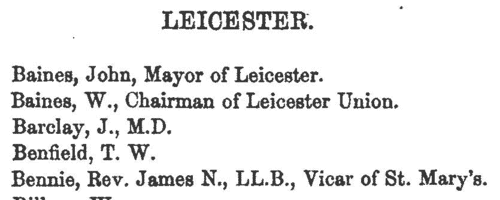
| Patentees of New Inventions
(1869)
Index of patentees and applicants for patents of inventions in 1869: giving full name of patentee (surname first); number of patent (in bold); date (within 1869); and subject-matter. Where the patentee was acting as agent for third parties, their names are given in italics in the subject-matter column. | Sample scan, click to enlarge

| Science Schools and Classes: Elementary Examination: Class Lists
(1869)
The Science and Art Department of the Committee of Council on Education published these class lists giving the names of all the successful candidates in the examination of science schools and classes taken in May 1869. The candidates were of three levels: honours; second stage or advanced examination; third stage or elementary examination. Twenty-three subjects were offered. These are the lists for the elementary examination. The tables, arranged subject by subject, give the candidate's full name (surname first), age, and occupation - or, in the case of those not yet of working age, father's occupation, preceded by (f.). Many candidates sat and were successful in more than one subject, and so appear in more than one list. The subjects are: I. Practical, Plane and Solid Geometry; II. Machine Construction; III. Building Construction; IV. Elementary Mathematics; V. Higher Mathematics; VI. Theoretical Mechanics; VII. Applied Mechanics; VIII. Acoustics, Light, and Heat: IX. Magnetism and Electricity; X. Inorganic Chemistry; XI. Organic Chemistry; XII. Geology; XIII. Mineralogy; XIV. Animal Physiology; XV. Zoology; XVI. Vegetable Anatomy and Physiology; XVII. Systematic and Economic Botany; XVIII. Mining; XIX. Metallurgy; XX. Navigation; XXI. Nautical Astronomy; XXII. Steam; XXIII. Physical Geography. | Sample scan, click to enlarge

| Science Schools and Classes: Honours and Advanced Examinations: Class Lists
(1869)
The Science and Art Department of the Committee of Council on Education published these class lists giving the names of all the successful candidates in the examination of science schools and classes taken in May 1869. The candidates were of three levels: honours; second stage or advanced examination; third stage or elementary examination. Twenty-three subjects were offered. These are the lists for the honours and advanced examinations. The tables, arranged subject by subject, give the candidate's full name (surname first), age, and occupation - or, in the case of those not yet of working age, father's occupation, preceded by (f.); the name of the school where the candidate was taught the subject; and the name of the teacher. Many candidates sat and were successful in more than one subject, and so appear in more than one list. The subjects are: I. Practical, Plane and Solid Geometry; II. Machine Construction; III. Building Construction; IV. Elementary Mathematics; V. Higher Mathematics; VI. Theoretical Mechanics; VII. Applied Mechanics; VIII. Acoustics, Light, and Heat: IX. Magnetism and Electricity; X. Inorganic Chemistry; XI. Organic Chemistry; XII. Geology; XIII. Mineralogy; XIV. Animal Physiology; XV. Zoology; XVI. Vegetable Anatomy and Physiology; XVII. Systematic and Economic Botany; XVIII. Mining; XIX. Metallurgy; XX. Navigation; XXI. Nautical Astronomy; XXII. Steam; XXIII. Physical Geography. | Sample scan, click to enlarge

|  Men of the 57th Regiment who fought in the New Zealand War
(1860-1870) Men of the 57th Regiment who fought in the New Zealand War
(1860-1870)
New Zealand War Medal roll for the 57th (The West Middlesex) Regiment of Foot: for service in the New Zealand campaign 1863 to 1867: the rolls were compiled following a general order in 1869 and the medals were distributed in 1870. The regiment had been serving at Poonah in India, and was moved to New Zealand in November 1860; the men returned to England in April 1867. | Sample scan, click to enlarge

|  Outstanding soldiers of the 10th regiment of Hussars
(1860-1870) Outstanding soldiers of the 10th regiment of Hussars
(1860-1870)
The 10th (The Prince of Wales' Own) Royal Regiment of Hussars or Light Dragoons returned from the Crimea in 1856. The headquarters were at Hounslow. Each year just a handful of outstanding soldiers of the regiment were chosen for good conduct medals and gratuities: these are listed here. There were two lists, one for men recommended for the Good Conduct Medal without a gratuity, and one for gratuities - £5 to a private, £10 to a corporal, and £15 to a serjeant. Both lists are indexed here, and each gives rank, name, regimental number, date of recommendation and date of issue. (The sample scan is from the 105th foot) | Sample scan, click to enlarge
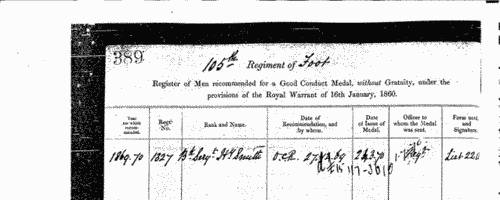
|  Outstanding soldiers of the 12th regiment of Lancers
(1860-1870) Outstanding soldiers of the 12th regiment of Lancers
(1860-1870)
The 12th (Prince of Wales's) Royal Regiment of Lancers, having returned from the Crimea, was sent off to India within a couple of months. The home depot was at Maidstone. By 1860 the regiment was serving at Secunderabad, but in that year returned to England; and served in Ireland 1865 to 1870. Each year just a handful of outstanding soldiers of the regiment were chosen for good conduct medals and gratuities: these are listed here. There were two lists, one for men recommended for the Good Conduct Medal without a gratuity, and one for gratuities - £5 to a private, £10 to a corporal, and £15 to a serjeant. Both lists are indexed here, and each gives rank, name, regimental number, date of recommendation and date of issue. (The sample scan is from the 105th foot) | Sample scan, click to enlarge
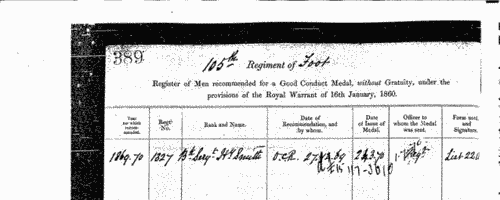
|  Outstanding soldiers of the 20th regiment of Foot
(1860-1870) Outstanding soldiers of the 20th regiment of Foot
(1860-1870)
The 20th (The East Devonshire) Regiment of Foot was in two battalions. The 1st battalion fought in the Crimea, and in 1857 was moved to India, where it took part in the capture of Lucknow. The battalion returned to England in 1867: the depot was at Chatham. In 1869 the battalion was moved to Ireland. The second battalion was raised in Ireland in 1858, and was at Dublin in 1860, and in England by 1861: in 1863 it embarked for China; 1864 to Japan; 1866 back to China; 1867 to the Cape of Good Hope; 1870 to Mauritius. Each year just a handful of outstanding soldiers of the regiment were chosen for good conduct medals and gratuities: these are listed here. There were two lists, one for men recommended for the Good Conduct Medal without a gratuity, and one for gratuities - £5 to a private, £10 to a corporal, and £15 to a serjeant. Both lists are indexed here, and each gives rank, name, regimental number, date of recommendation and date of issue. (The sample scan is from the 105th foot) | Sample scan, click to enlarge
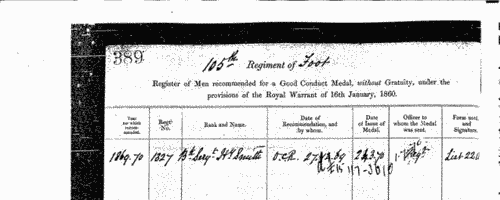
|  Outstanding soldiers of the 68th regiment of Foot
(1860-1870) Outstanding soldiers of the 68th regiment of Foot
(1860-1870)
The 68th (The Durham) Regiment of Foot (Light Infantry) fought in the Crimea, then in 1857 was sent to Burmah. In 1864 the troops were moved to New Zealand, and took part in the conflict there. They returned to England in 1866: the regimental depot was at Fermoy in Ireland. Each year just a handful of outstanding soldiers of the regiment were chosen for good conduct medals and gratuities: these are listed here. There were two lists, one for men recommended for the Good Conduct Medal without a gratuity, and one for gratuities - £5 to a private, £10 to a corporal, and £15 to a serjeant. Both lists are indexed here, and each gives rank, name, regimental number, date of recommendation and date of issue. (The sample scan is from the 105th foot) | Sample scan, click to enlarge
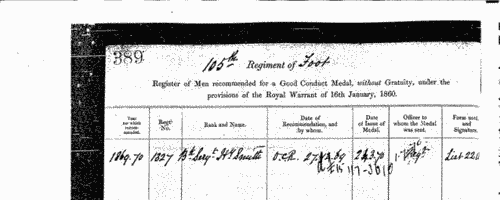
|  Outstanding soldiers of the 71st regiment of Foot
(1860-1870) Outstanding soldiers of the 71st regiment of Foot
(1860-1870)
The 71st (Highland) Regiment of Foot (Light Infantry) embarked for Corfu in 1853. The regimental depot was at Perth. Each year just a handful of outstanding soldiers of the regiment were chosen for good conduct medals and gratuities: these are listed here. There were two lists, one for men recommended for the Good Conduct Medal without a gratuity, and one for gratuities - £5 to a private, £10 to a corporal, and £15 to a serjeant. Both lists are indexed here, and each gives rank, name, regimental number, date of recommendation and date of issue. (The sample scan is from the 105th foot) | Sample scan, click to enlarge
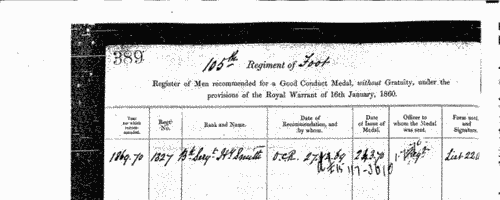
|
Research your ancestry, family history, genealogy and one-name study by direct access to original records and archives indexed by surname.
|












